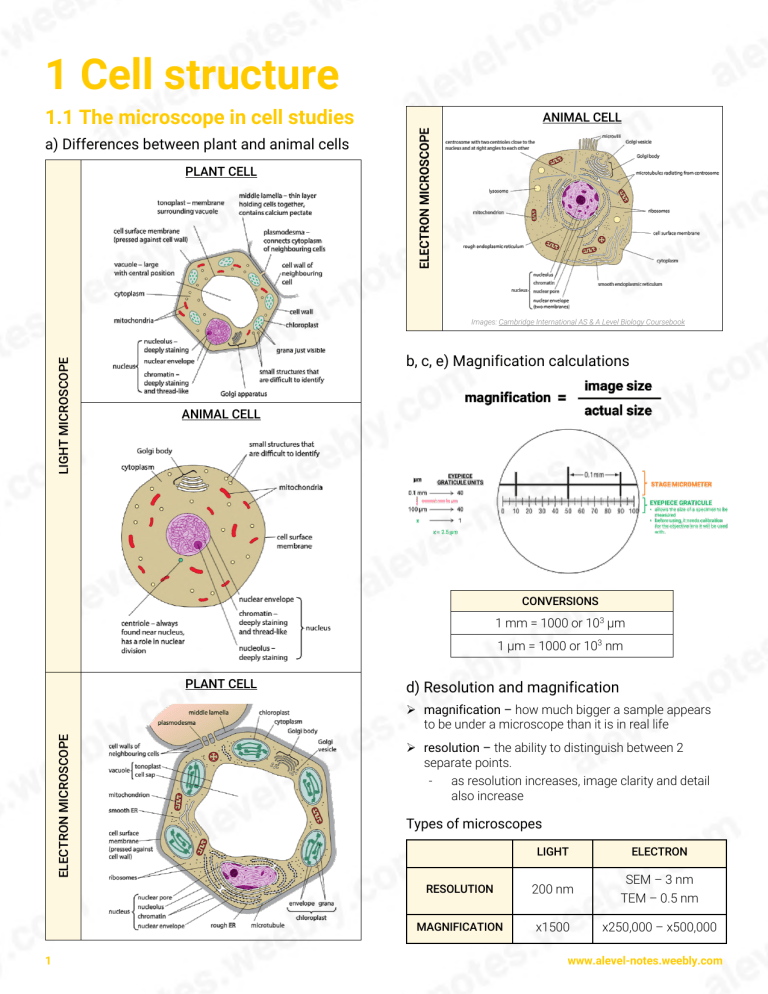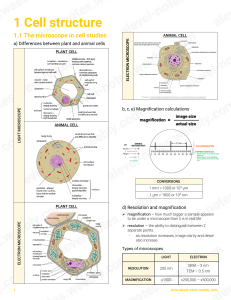
1 Cell structure 1.1 The microscope in cell studies ANIMAL CELL a) Differences between plant and animal cells PLANT CELL LIGHT MICROSCOPE Images: Cambridge International AS & A Level Biology Coursebook b, c, e) Magnification calculations ANIMAL CELL CONVERSIONS 1 mm = 1000 or 103 µm 1 µm = 1000 or 103 nm PLANT CELL d) Resolution and magnification ELECTRON MICROSCOPE Ø magnification – how much bigger a sample appears to be under a microscope than it is in real life 1 Ø resolution – the ability to distinguish between 2 separate points. - as resolution increases, image clarity and detail also increase Types of microscopes LIGHT ELECTRON RESOLUTION 200 nm SEM – 3 nm TEM – 0.5 nm MAGNIFICATION x1500 x250,000 – x500,000 www.alevel-notes.weebly.com a) • • Light microscopes limit of resolution: half the wavelength ribosomes (25nm) can’t be seen with a light microscope as they don’t interfere with the light waves a) Electron micrographs of plant and animal cells a) Plant cells Image: https://cronodon.com/BioTech/Plant_Bodies_Cells.html Image: Cambridge International AS & A Level Biology Coursebook • different stains are absorbed by different cell organelles so they can be observed more clearly b) • Electron microscopes vacuum (electrons cannot be focused without a vacuum as they will collide with air molecules and scatter) water boils at room temperature in a vacuum, so the sample must be dehydrated (specimen has to be dead) • Advantages of a light microscope over an electron microscope 1) can observe living tissue 2) more portable 3) easier to use - no technical training required 4) possible to see real/natural colours and a live specimen 5) can stain particular types of tissue for better visibility Image: https://www.tuttee.co/blog/gce-cie-biology-animal-and-plant-cell-structures-and-functions b) Animal cells 1.2 Cells as the basic units of living organisms The cell is the basic unit of all living organisms. The interrelationships between these cell structures show how cells function to transfer energy, produce biological molecules including proteins and exchange substances with their surroundings. 2 Image: https://brainly.in/question/1540878 www.alevel-notes.weebly.com • carry out protein synthesis 80S – cytoplasm 70S – chloroplasts & mitochondria 4) Rough endoplasmic reticulum (RER) • membranes that form an extended system of fluidfilled sacs (cisternae) single membraned organelle ribosomes are attached to the RER and are the site of protein synthesis proteins made by the ribosomes enter the sacs and are often modified as they go through them small sacs (vesicles) break off from the ER and join to form the golgi body • • • • Image: https://www.tuttee.co/blog/gce-cie-biology-animal-and-plant-cell-structures-and-functions • b) Eukaryotic cell structures and their functions 1) Cell surface membrane (phospholipid bilayer) (7 nm) • • • • selectively permeable membrane that allows for the exchange of certain substances barrier between cytoplasm and external environment cell recognition (surface antigens) selection of substances that enter/leave cells 2) Nucleus (7 µm) Controls cell’s activities very dense, takes up colour the most when stained • divides first during cell division • surrounded by 2 membranes, known as the nuclear envelope which is continuous with the RER. • • Image: Esrefoglu, Mukaddes. (2019). The Golgi Apparatus: Morphology and Function with Recent Facts. Bezmialem Science. 7. 331-338. 10.14235/bas.galenos.2019.2806. 5) Golgi body / apparatus / complex Image: https://courses.lumenlearning.com/boundless-ap/chapter/the-nucleus-and-ribosomes/ • contains: a) nuclear pores: allow and control substances entering in (protein to make ribosomes, ATP, some hormones, nucleotides) and leaving (mRNA, ribosomes for protein synthesis) of nucleus b) nucleolus (2.5 µm): contains loops DNA from several chromosomes and synthesises ribisomes 3) Ribosomes (25 nm) • composed of 2 subunits Image: https://www.open.edu/openlearn/ 3 Image: https://microbenotes.com/golgi-apparatus-structure-and-functions/ • • • • • • • • stack of flattened sacs (cisternae) formed by the vesicles which bud off from the RER Single membraned organelle Packages substances into vesicles for transport glycosylation phosphorylating proteins assembly of polypeptides into proteins (4º structure) folding proteins removing the 1st amino acid methionine to activate proteins www.alevel-notes.weebly.com • 6) • Smooth endoplasmic reticulum (SER) synthesizes lipids and steroids such as cholesterol and the reproductive hormones estrogen and testosterone. • • • • 9) energy released from energy-rich molecules e.g., sugars and fats during respiration is transferred to molecules of ATP ATP is the energy-carrying molecule in all living cells once made, ATP leaves the mitochondrion and can spread rapidly to all parts of the cell where energy is needed its energy is released by breaking ATP down to ADP (adenosine diphosphate) in a hydrolysis reaction see Chapter 12.2(i) for more details Microtubules Image: https://studiousguy.com/ 7) • • • • • • Lysosomes (0.1-1µm) spherical sacs surrounded by a single membrane not permanent structures no internal structure contain hydrolytic enzymes responsible for digestion/breakdown of unwanted structures e.g., old organelles can even digest whole cells e.g., in mammary glands after the period of lactation Image: https://www.microscopemaster.com/alpha-and-beta-tubulins.html • • • • • • • long, rigid, hollow tubes found in the cytoplasm made of a protein called tubulin tubulin has 2 forms – ⍺ & β tubulin ⍺ & β tubulin molecules combine to form dimers many dimers are joined end to end to form protofilaments 13 protofilaments are in a ring to form a cylinder with a hollow center this cylinder is the microtubule Image: https://www.ybstudy.com/2020/07/lysosomes-structure-functions.html?m=1 8) Mitochondria (0.5-10µm) • • supports and gives shapes to the cell the assembly of microtubules from tubulin molecules is controlled by special locations in cells called microtubule organizing centers (MTOCs) 9.5) Centrioles (and centrosomes) • outside the nucleus of animal cells, 2 centrioles are present close together at right angles in a region called the centrosome Image: https://brainly.in/question/21632838 • • • • carries out aerobic respiration synthesizes ATP (adenosine triphosphate) more in cells that have a higher demand for energy e.g., muscle, liver, and root hair cells outer membrane contains a transport protein called porin Image: https://www.microscopemaster.com/centriole.html 4 www.alevel-notes.weebly.com 13) Vacuoles • • • centrioles are hollow cylinders about 500 nm long produces spindle fibers organizes microtubules • surrounded by a partially permeable tonoplast which controls exchange between the vacuole and cytoplasm • • helps regulate osmotic properties of cells fluid present in the vacuole consists of: 10) Chloroplasts (3-10µm) Image: https://askmicrobiology.com/do-bacteria-have-chloroplast/ • • • • • diameter 3-10 um carries out photosynthesis contains starch grains, circular DNA, and 70S ribosomes ATP is also produced here see Chapter 13.3(a) for more details • 11) Cell wall • • • • gives cell definite shape rigid as made of cellulose freely permeable prevents cell from bursting 12) Plasmodesmata • d) Structural features of prokaryotic cells plant cells are linked to neighboring cells by means of fine strands of cytoplasm called plasmodesmata which pass through pore-like structures in their walls • • • • • • • organisms that lack nuclei or proper nuclear membranes are called prokaryotes unicellular 1-5um cell wall made of murein (peptidoglycan = protein + polysaccharides) no membranes around organelles 70S (smaller) ribosomes genetic material in the form of circular DNA have no ER Image: https://mybody101.com/ap-bio-unit-4/ • • • allows the transport of water, sucrose, amino acids, ions, etc., between cells without crossing membranes this is called movement through the symplastic pathway allows communication/signaling between cells. Image: Cambridge International AS & A Level Biology Coursebook 5 www.alevel-notes.weebly.com e) Differences between typical eukaryotic and prokaryotic cells Image: https://www.researchgate.net/fi See Chapter 18.2 for more details f) Viruses Image: Cambridge International AS & A Level Biology Coursebook • • • • • • • • 6 noncellular/acellular protein coat nucleic acid core; DNA/RNA strand replicate inside host cells only show no characteristics of living organism symmetrical shape the virus DNA/RNA takes over the protein synthesizing machinery of the host cell which helps to make new virus particles See Chapter 18.2(d) for more details www.alevel-notes.weebly.com







